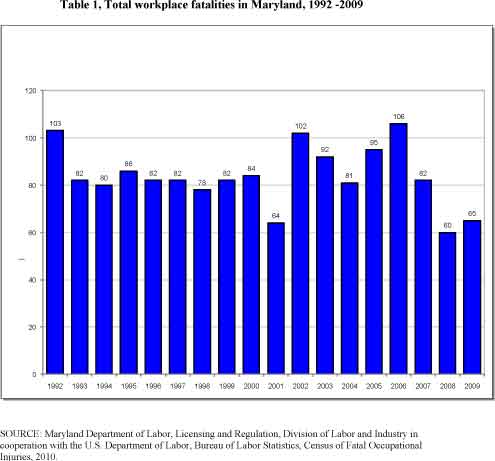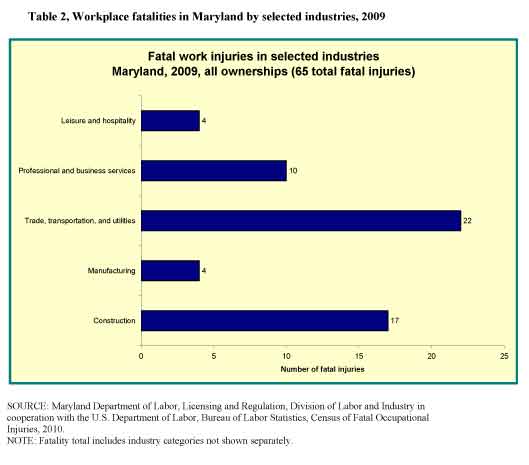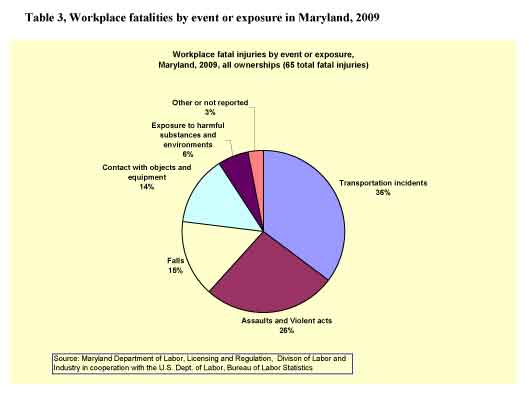Download this document (Word document,
63KB, download Word viewer for free)
(PDF document, 98KB,
download Adobe Acrobat for free)
Maryland Workplace Fatalities Increased in 2009
Fatal work injuries in Maryland totaled 65 in 2009 according to the preliminary results of the Census of
Fatal Occupational Injuries (CFOI) program. Although this is an eight-percent increase from the previous
year's total of 60, it is the third lowest count for the State since the fatality program's inception in 1992.
The increase was due to a spike in the number of workplace assaults and violent acts which went from 9 reported
cases in 2008 to 17 in 2009.
The CFOI program is a collaborative effort between the Maryland Department of Labor, Licensing and Regulation,
Division of Labor and Industry and the U.S. Department of Labor, Bureau of Labor Statistics.
Key findings for the Maryland Census of Fatal Occupational Injuries, 2009
- The most frequent types of fatal workplace events in 2009 were homicides with 14 cases, falls to a lower
level with 10, highway crashes with 9, and pedestrian accidents with 6. Together these four types of fatal
occurrences accounted for 60 percent of worker deaths in the State of Maryland for 2009.
- Workplace homicides rose from 9 reported cases in 2008 to14 for 2009. Homicides accounted for 22 percent
of the State's total and 12 percent of the nation's.
- Deaths from falls to a lower level increased by one case from 9 reported in 2008 to 10 in 2009. This type
of event represented 15 percent of the total for all fatal work injuries that occurred in Maryland and 12
percent for the nation.
- In 2009 three workers died after coming into contact with electric current; fatal electrocutions were
down from 8 reported cases in 2008.
- From 2005 through 2009, there were 21 work-related fatalities in Maryland associated with electrocution.
Slightly over three-quarters of these workers were in the construction industry. All were men. Sixty-two
percent were white, non-Hispanic; 19 percent, black, non-Hispanic; and 9 percent, Hispanic. Deaths due to
contact with electric current comprised 5 percent of fatal work injuries in the State and 4 percent nationwide.
- The number of fatalities resulting from highway incidents increased slightly from 7 reported cases in
2008 to 9 for 2009. Deaths due to highway incidents represented 14 percent of Maryland's occupational
fatalities and 20 percent of the nation's total.
|
Technical Notes
The Census of Fatal Occupational Injuries and Illnesses (CFOI) is a cooperative program between the State of
Maryland, Department of Labor, Licensing and Regulation, Division of Labor an Industry and the U.S. Department
of Labor, Bureau of Labor Statistics. CFOI provides a complete count of all fatal work injuries occurring in
Maryland and in the United States in each calendar year. The program uses diverse State and federal data sources
to identify, verify and profile fatal work injuries. Information about each workplace fatality (industry,
occupation, and other worker characteristics; equipment being used; and circumstances of the event) is obtained
by cross-referencing multiple source documents , such as death certificates, workers' compensation reports,
news media accounts, and reports to State and federal agencies. Diverse sources are used because studies have
shown that no single source captures all job-related fatalities. The documents are matched so that each fatality
is counted only once. To ensure that a fatality occurred while the decedent was at work, information is verified
from two or more independent source documents. This method assures counts are as complete and accurate as
possible.
For a fatality to be included in the census, the decedent must have been employed (that is, working for pay,
compensation, or profit) at the time of the event, engaged in a legal work activity, or present at the site of
the incident as a requirement of his or her job. Fatalities to volunteers and unpaid family workers who perform
the same duties and functions as paid workers are also included in the count. These criteria are generally
broader than those used by State and federal agencies administering specific laws and regulations. (Fatalities
that occur during a person's normal commute to or from work are excluded from the census counts.)
Data presented in this release include deaths occurring in 2008 that resulted from traumatic occupational
injuries. An injury is defined as any wound or damage to the body resulting from acute exposure to energy,
such as heat, electricity, or impact from a crash or fall, or from the absence of such essentials as heat or
oxygen, caused by a specific event or incident within a single workday or shift. Included are open wounds,
intracranial and internal injuries, heatstroke, hypothermia, asphyxiation, acute poisonings resulting from
short-term exposures limited to the worker's shift, suicides and homicides, and work injuries listed as
underlying or contributory causes of death.
The CFOI program presents data for all fatal work injuries, regardless of whether the decedent was working
in a job covered under the regulatory oversight of the Maryland Occupational Safety and Health Agency or other
State and Federal agencies. Thus, any comparison between the Maryland CFOI counts and those released by other
agencies should take into account the different coverage requirements and definitions being used by each agency.
Information on work-related fatal illnesses is not reported in the Maryland Census of Fatal Occupational
Injuries because the latency period associated with many types of occupational illness, and the difficulty of
linking those illnesses to work exposures, make identification of a universe problematic. |



